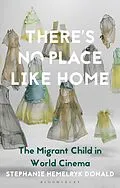Choice Outstanding Academic Title 2018 The Wizard of Oz brought many now-iconic tropes into popular culture: the yellow brick road, ruby slippers and Oz. But this book begins with Dorothy and her legacy as an archetypal touchstone in cinema for the child journeying far from home. In There's No Place Like Home, distinguished film scholar Stephanie Hemelryk Donald offers a fresh interpretation of the migrant child as a recurring figure in world cinema. Displaced or placeless children, and the idea of childhood itself, are vehicles to examine migration and cosmopolitanism in films such as Le Ballon Rouge, Little Moth and Le Havre. Surveying fictional and documentary film from the post-war years until today, the author shows how the child is a guide to themes of place, self and being in world cinema.
Autorentext
Stephanie Hemelryk Donald is Professor of Film at Monash University Malaysia and Head of the School of Arts and Social Sciences. Since 2018 she has worked in the Justice, Arts and Migration Network (Lincoln-Sydney-Hong Kong) on artivist interventions that highlight state injustices against people, including children, on migrant journeys. This work was made possible by Natasha Davis (The Big Walk: It Takes a Decade, 2020), Hoda Afshar (Remain / There's No Place Like Home, 2019), the SYMAAG, Maison de Femmes, and Right to Remain organisers in Dunquerque, Manchester, and Sheffield, and the curators at Mansions of the Future (Lincoln 2018-2020).
Klappentext
Choice Outstanding Academic Title 2018
The Wizard of Oz brought many now-iconic tropes into popular culture: the yellow brick road, ruby slippers and Oz. But this book begins with Dorothy and her legacy as an archetypal touchstone in cinema for the child journeying far from home. In There's No Place Like Home, distinguished film scholar Stephanie Hemelryk Donald offers a fresh interpretation of the migrant child as a recurring figure in world cinema. Displaced or placeless children, and the idea of childhood itself, are vehicles to examine migration and cosmopolitanism in films such as Le Ballon Rouge, Sammy Going South and Le Havre. Surveying fictional and documentary film from the post-war years until today, the author shows how the child is a guide to themes of place, self and being in world cinema.
Zusammenfassung
Choice Outstanding Academic Title 2018The Wizard of Oz brought many now-iconic tropes into popular culture: the yellow brick road, ruby slippers and Oz. But this book begins with Dorothy and her legacy as an archetypal touchstone in cinema for the child journeying far from home. In There's No Place Like Home, distinguished film scholar Stephanie Hemelryk Donald offers a fresh interpretation of the migrant child as a recurring figure in world cinema. Displaced or placeless children, and the idea of childhood itself, are vehicles to examine migration and cosmopolitanism in films such as Le Ballon Rouge, Little Moth and Le Havre. Surveying fictional and documentary film from the post-war years until today, the author shows how the child is a guide to themes of place, self and being in world cinema.
Inhalt
Foreword: Childhood as method
Introduction
The Dorothy Complex; migration, childhood and the fantasies of Oz
Chapter One
Stranded Citizens and the Family Romance
Chapter Two
Playing for Keeps
Chapter Three
Journeys
Chapter Four
Arrival, Settlement and Relationality
Chapter Five
Urban mobility: Children and the Right to the City
Chapter 6
Forced Inertia: Mobility, Interruption, and Stasis
Conclusion
Flattened Ontologies: Home beyond Kansas
